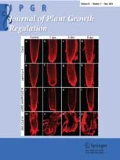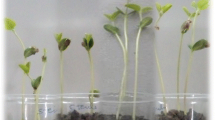Abstract
The aim of this work was to compare the different responses of the root and the shoot to salt stress with or without growth-promoting bacteria Pseudomonas putida Rs-198 application. The results revealed that lower salt stress did not show bad effects on plant growth although osmotic tolerance indictors were observed. The results showed that proline content increased by 7.75% and 20.20% in shoot and 323.73% and 449.38% in root under 150 mM and 300 mM salt treatment, respectively. Increasing salt stress also led to a reduction of peroxides enzyme (POD) activity by 16.50% and 15.49% in the shoot and 46.03% and 39.36% in the root under above salt treatments. More importantly, the changes observed in pepper roots were more pronounced than those in pepper shoots except for total soluble sugar and protein. In addition, inoculation of Pseudomonas putida Rs-198 could relieve the changes of these indicators. Further, these changes were more pronounced in non-inoculated control plants than in inoculated plants. Especially, Pseudomonas putida Rs-198-inoculated plants exhibited the greatest increase in polyphenol oxidase activity by 78.06% in shoot and POD activity by 25.22% in root compared with the non-inoculated plants at 150 mM NaCl stress. To the best of our knowledge, these results are the first reported that will more effectively explain the phenomena relationship between plant, salt stress, and plant growth-promoting bacteria.
Graphical Abstract
Physiological changes induced by Pseudomonas putida Rs-198 interaction in Capsicum annuum L. under salt stress.







Similar content being viewed by others
References
Abdel Latef AAH (2011) Influence of arbuscular mycorrhizal fungi and copper on growth, accumulation of osmolyte, mineral nutrition and antioxidant enzyme activity of pepper (Capsicum annuum L.). Mycorrhiza 21:495–503. https://doi.org/10.1007/s00572-010-0360-0
Abdel Latef AAH, Chaoxing H (2014) Does inoculation with Glomus mosseae improve salt tolerance in pepper plants? J Plant Growth Regul 33: 644–653. https://doi.org/10.1007/s00344-014-9414-4
Abhayashree MS, Murali M, Amruthesh KN (2016) Abiotic elicitors mediated resistance and enhanced defense related enzymes in Capsicum annuum L. against anthracnose disease. Sci Hortic 204:172–178. https://doi.org/10.1016/j.scienta.2016.04.004
Ali S, Rizwan M, Qayyum MF, Ok YS, Ibrahim M, Riaz M, Arif MS, Hafeez F, Al-Wabel MI, Shahzad AN (2017) Biochar soil amendment on alleviation of drought and salt stress in plants: a critical review. Environ Sci Pollut Res Int 24:12700–12712. https://doi.org/10.1007/s11356-017-8904-x
Bano A, Fatima M (2009) Salt tolerance in Zea mays (L.) following inoculation with Rhizobium and Pseudomonas. Biol Fertil Soil 45:405–413
Bernstein N, Sela Saldinger S, Dudai N, Gorbatsevich E (2017) Salinity stress does not affect root uptake, dissemination and persistence of salmonella in sweet-basil (Ocimum basilicum). Front Plant Sci 8:675. https://doi.org/10.3389/fpls.2017.00675.
Bojorquez-Quintal E, Ruiz-Lau N, Velarde-Buen A, Echevarria-Machado I, Pottosin I, Martinez-Estevez M (2016) Natural variation in primary root growth and K+ retention in roots of habanero pepper (Capsicum chinense) under salt stress. Funct Plant Biol 43:1114
Bradford MM (1976) A rapid and sensitive method for the quantitation of microgram quantities of protein utilizing the principle of protein-dye binding. Anal Biochem 72:248–254
Bulle M, Yarra R, Abbagani S (2016) Enhanced salinity stress tolerance in transgenic chilli pepper (Capsicum annuum L.) plants overexpressing the wheat antiporter (TaNHX2) gene. Mol Breed 36:36. https://doi.org/10.1007/s11032-016-0451-5
Chen L, Liu Y, Gw Wu, Veronican Njeri K, Shen Q, Zhang N, Zhang R (2016) Induced maize salt tolerance by rhizosphere inoculation of Bacillus amyloliquefaciens SQR9. Physiol Plant 158:34–44
Di Martino C, Delfine S, Pizzuto R, Loreto F, Fuggi A (2003) Free amino acids and glycine betaine in leaf osmoregulation of spinach responding to increasing salt stress. New Phytol 158:455–463
Dubois M, Gilles KA, Hamilton JK, Rebers P, Smith F (1956) Colorimetric method for determination of sugars and related substances. Anal Chem 28:350–356
Fan JW, Du YL, Wang BR, Turner NC, Wang T, Abbott LK, Stefanova K, Siddique KHM, Li FM (2016) Forage yield, soil water depletion, shoot nitrogen and phosphorus uptake and concentration, of young and old stands of alfalfa in response to nitrogen and phosphorus fertilisation in a semiarid environment. Field Crop Res 198:247–257. https://doi.org/10.1016/j.fcr.2016.08.014
Farhangi-Abriz S, Torabian S (2017) Antioxidant enzyme and osmotic adjustment changes in bean seedlings as affected by biochar under salt stress. Ecotoxicol Environ Safe 137:64–70. https://doi.org/10.1016/j.ecoenv.2016.11.029
Goicoechea N, Merino S, Sánchez-Díaz M (2005) Arbuscular mycorrhizal fungi can contribute to maintain antioxidant and carbon metabolism in nodules of Anthyllis cytisoides L. subjected to drought. J Plant Physiol 162:27–35
Goudarzi M, Pakniyat H (2009) Salinity causes increase in proline and protein contents and peroxidase activity in wheat cultivars. J Appl Sci 9:348–353
Guo P, Song B, Xu L, Zheng Y, Li R, Zhang H, Huang H (2011) An improved spectrophotometric method for determination of betaine content in plants. J Guangzhou Univ (Nat Sci Ed) 10:32–36
Haddadi BS, Hassanpour H, Niknam V (2016) Effect of salinity and waterlogging on growth, anatomical and antioxidative responses in Mentha aquatica L. Acta Physiol Plant 38:119
He M, Dijkstra FA (2014) Drought effect on plant nitrogen and phosphorus: a meta-analysis. New Phytol 204:924–931
He Y, Wu Z, Ye B-C, Wang J, Guan X, Zhang J (2016) Viability evaluation of alginate-encapsulated Pseudomonas putida Rs-198 under simulated salt-stress conditions and its effect on cotton growth. Eur J Soil Biol 75:135–141. https://doi.org/10.1016/j.ejsobi.2016.05.002
Kang SM, Khan AL, Waqas M, You YH, Hamayun M, Joo GJ, Shahzad R, Choi KS, Lee IJ (2015) Gibberellin-producing Serratia nematodiphila PEJ1011 ameliorates low temperature stress in Capsicum annuum L. Eur J Soil Biol 68:85–93. https://doi.org/10.1016/j.ejsobi.2015.02.005
Kaya C, Ashraf M, Sonmez O, Aydemir S, Tuna AL, Cullu MA (2009) The influence of arbuscular mycorrhizal colonisation on key growth parameters and fruit yield of pepper plants grown at high salinity. Sci Hortic 121:1–6
Kim K, Jang Y-J, Lee S-M, Oh B-T, Chae J-C, Lee K-J (2014) Alleviation of salt stress by Enterobacter sp. EJ01 in tomato and Arabidopsis is accompanied by up-regulation of conserved salinity responsive factors in plants. Mol Cells 37:109
Krishnamoorthy R, Kim K, Subramanian P, Senthilkumar M, Anandham R, Sa T (2016) Arbuscular mycorrhizal fungi and associated bacteria isolated from salt-affected soil enhances the tolerance of maize to salinity in coastal reclamation soil. Agric Ecosyst Environ 231:233–239
Kumar A, Usmani Z, Kumar V (2017a) Biochar and flyash inoculated with plant growth promoting rhizobacteria act as potential biofertilizer for luxuriant growth and yield of tomato plant. J Environ Manag 190:20–27
Kumar K, Amaresan N, Madhuri K (2017b) Alleviation of the adverse effect of salinity stress by inoculation of plant growth promoting rhizobacteria isolated from hot humid tropical climate. Ecol Eng 102:361–366. https://doi.org/10.1016/j.ecoleng.2017.02.023.
Li X, Geng X, Xie R, Fu L, Jiang J, Gao L, Sun J (2016) The endophytic bacteria isolated from elephant grass (Pennisetum purpureum Schumach) promote plant growth and enhance salt tolerance of Hybrid Pennisetum. Biotechnol Biofuel 9:190. https://doi.org/10.1186/s13068-13016-10592-13060
Li YF, Fan Y, Ma Y, Zhang Z, Yue HB, Wang LJ, Li J, Jiao Y (2017) Effects of exogenous γ-aminobutyric acid (GABA) on photosynthesis and antioxidant system in pepper (Capsicum annuum L.) seedlings under low light stress. J Plant Growth Regul 36:436–449
Lichtenthaler HK, Wellburn AR (1983) Determinations of total carotenoids and chlorophylls a and b of leaf extracts in different solvents. Biochem Soc T 11:591–592. https://doi.org/10.1042/bst0110591.
Lv S, Yang A, Zhang K, Wang L, Zhang J (2007) Increase of glycinebetaine synthesis improves drought tolerance in cotton. Mol Breed 20:233–248. https://doi.org/10.1007/s11032-007-9086-x
Meng X, Zhao Q, Jin Y, Yu J, Yin Z, Chen S, Dai S (2016) Chilling-responsive mechanisms in halophyte Puccinellia tenuiflora seedlings revealed from proteomics analysis. J Proteom 143:365–381
Merati MJ, Hassanpour H, Niknam V, Mirmasoumi M (2014) Exogenous application of penconazole regulates plant growth and antioxidative responses in salt-stressed Mentha pulegium L. J Plant Interact 9:791–801
Nautiyal CS (1999) An efficient microbiological growth medium for screening phosphate solubilizing microorganisms. FEMS Microbiol Lett 170:265–270
Nautiyal CS, Srivastava S, Chauhan PS, Seem K, Mishra A, Sopory SK (2013) Plant growth-promoting bacteria Bacillus amyloliquefaciens NBRISN13 modulates gene expression profile of leaf and rhizosphere community in rice during salt stress. Plant Physiol Biochem 66:1–9. https://doi.org/10.1016/j.plaphy.2013.01.020
Olaiya C, Poloamina L (2013) Changes in the contents of carotenoid, chlorophyll and antioxidant enzymes in the leaf tissues of Pepper (Capsicum annuum L.) following exogenous application of bioregulators. Nat Sci 11:9–13
Orlikowska T, Nowak K, Reed B (2016) Bacteria in the plant tissue culture environment. PCTOC 128: 487–508. https://doi.org/10.1007/s11240-016-1144-9
Osakabe Y, Osakabe K, Shinozaki K, Tran LS (2014) Response of plants to water stress. Front Plant Sci 5: 86. https://doi.org/10.3389/fpls.2014.00086
Oves M, Khan MS, Zaidi A (2013) Chromium reducing and plant growth promoting novel strain Pseudomonas aeruginosa OSG41 enhance chickpea growth in chromium amended soils. Eur J Soil Biol 56:72–83. https://doi.org/10.1016/j.ejsobi.2013.02.002
Oves M, Khan MS, Qari HA (2017) Ensifer adhaerens for heavy metal bioaccumulation, biosorption, and phosphate solubilization under metal stress condition. J Taiwan Inst Chem Eng 80:540–552. https://doi.org/10.1016/j.jtice.2017.08.026
Pan Y, Wu LJ, Yu ZL (2006) Effect of salt and drought stress on antioxidant enzymes activities and SOD isoenzymes of liquorice (Glycyrrhiza uralensis Fisch). Plant Growth Regul 49:157–165
Parida AK, Das AB (2005) Salt tolerance and salinity effects on plants: a review. Ecotox Environ Safe 60:324–349. https://doi.org/10.1016/j.ecoenv.2004.06.010
Pinero MC, Perez-Jimenez M, Lopez-Marin J, Del Amor FM (2016) Changes in the salinity tolerance of sweet pepper plants as affected by nitrogen form and high CO2 concentration. J Plant Physiol 200:18–27. https://doi.org/10.1016/j.jplph.2016.05.020.
Sandhya V, Ali SZ, Grover M, Reddy G, Venkateswarlu B (2010) Effect of plant growth promoting Pseudomonas spp. on compatible solutes, antioxidant status and plant growth of maize under drought stress. Plant Growth Regul 62:21–30
Sawers RJ, Gutjahr C, Paszkowski U (2008) Cereal mycorrhiza: an ancient symbiosis in modern agriculture. Trends Plant Sci 13:93–97
Shalaby T, Bayoumi Y, Alshaal T, Elhawat N, Sztrik A, El-Ramady H (2017) Selenium fortification induces growth, antioxidant activity, yield and nutritional quality of lettuce in salt-affected soil using foliar and soil applications. Plant Soil 421:245–258. https://doi.org/10.1007/s11104-017-3458-8
Singh SP, Gaur R (2017) Endophytic Streptomyces spp. underscore induction of defense regulatory genes and confers resistance against Sclerotium rolfsii in chickpea. Biol Control 104:44–56. https://doi.org/10.1016/j.biocontrol.2016.10.011
Troll W, Lindsley J (1955) A photometric method for the determination of proline. J Biol Chem 215:655–660
Tu L, He Y, Shan C, Wu Z (2016) Preparation of microencapsulated Bacillus subtilis SL-13 seed coating agents and their effects on the growth of cotton seedlings. BioMed Res Int. https://doi.org/10.1155/2016/3251357
Wu Z, Guo L, Zhao Y, Li C (2014a) Effect of free and encapsulated Raoultella planticola Rs-2 on cotton growth promotion under salt stress. J Plant Nutr 37:1187–1201
Wu Z, Peng Y, Guo L, Li C (2014b) Root colonization of encapsulated Klebsiella oxytoca Rs-5 on cotton plants and its promoting growth performance under salinity stress. Eur J Soil Biol 60:81–87
Yang Y, Tang M, Sulpice R, Chen H, Tian S, Ban Y (2014) Arbuscular mycorrhizal fungi alter fractal dimension characteristics of Robinia pseudoacacia L. seedlings through regulating plant growth, leaf water status, photosynthesis, and nutrient concentration under drought stress. J Plant Growth Regul 33:612–625
Yao L, Wu Z, Zheng Y, Kaleem I, Li C (2010) Growth promotion and protection against salt stress by Pseudomonas putida Rs-198 on cotton. Eur J Soil Biol 46:49–54
Zhou J, Ruiting J, Li B, Wu J (2017) Responses of soil biota and nitrogen availability to an invasive plant under aboveground herbivory. Plant Soil 415:479–491
Acknowledgements
We would like to thank Mike DiLegge, Vincent Lopez form Center of Rhizosphere Biology, Colorado State University for the review and language edit.
Funding
This work was financially supported by Natural Science Foundation of China (31260022, 21566035), Postgraduate Education Reform and Innovation Program of Autonomous Regions (XJGR12016031), Scientific Research Foundation for Changjiang Scholars of Shihezi University (CJXZ201501). Yanhui He was supported by China Scholarship Council (No. 201709505007).
Author information
Authors and Affiliations
Corresponding author
Ethics declarations
Conflict of interest
The authors declare that there are no conflicts of interest.
Rights and permissions
About this article
Cite this article
He, Y., Wu, Z., Wang, W. et al. Different Responses of Capsicum annuum L. Root and Shoot to Salt Stress with Pseudomonas putida Rs-198 Inoculation. J Plant Growth Regul 38, 799–811 (2019). https://doi.org/10.1007/s00344-018-9891-y
Received:
Accepted:
Published:
Issue Date:
DOI: https://doi.org/10.1007/s00344-018-9891-y




